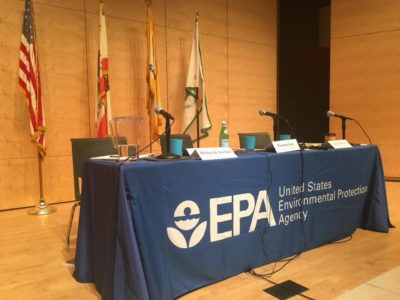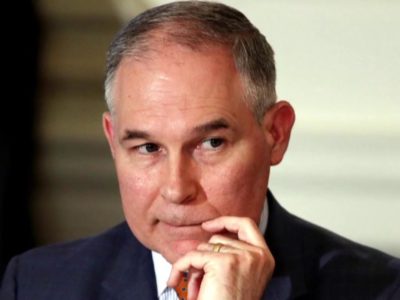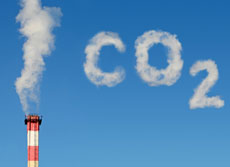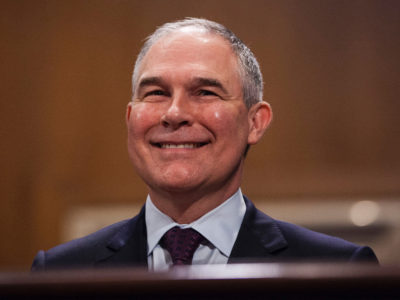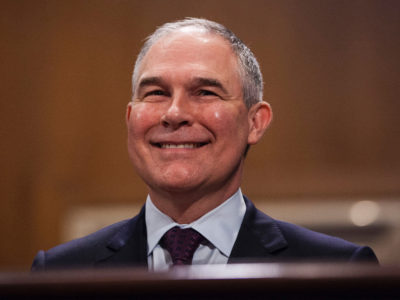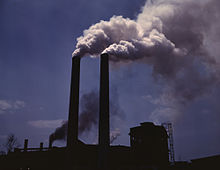Clean Air Act
The Questionable Legal Basis of the “Transparency” Proposal
EPA seems unsure of the legal authority for its proposal — and for good reason.
“They sat at the Agency and said, ‘what can we do to reimagine authority under the statutes to regulate an area that we are unsure that we can but we’re going to do so anyway?’” When he said those words, Scott Pruitt was talking about the Obama Administration. But it seems to be a pretty …
Continue reading “The Questionable Legal Basis of the “Transparency” Proposal”
CONTINUE READINGThe New EPA Plan To Roll Back Auto Emissions Standards and “Supersede” the California Waiver is Legally Indefensible
It is also terrible for the planet
The Los Angeles Times is reporting that EPA will propose to roll back greenhouse gas emissions standards for automobiles to 2020 levels. EPA will also claim that the California waiver is superseded by fuel economy standards issued by NHTSA and therefor is not valid, according to the report: Administration lawyers argue that the law gives …
CONTINUE READINGWhy California gets to write its own auto emissions standards: 5 questions answered
Authored by Nicholas Bryner and Meredith Hankins
Rush hour on the Hollywood Freeway, Los Angeles, September 9, 2016. AP Photo/Richard Vogel This article was originally published on The Conversation. Read the original article. Editor’s note: On April 2, Environmental Protection Agency Administrator Scott Pruitt announced that the Trump administration plans to revise tailpipe emissions standards negotiated by the Obama administration for motor …
CONTINUE READINGScott Pruitt’s Faulty Logic
There’s a gaping hole in Pruitt’s argument for repealing the Obama’s climate change rule.
An earlier blog post pointed to a logical gap in the current EPA’s justification for repealing the Clean Power Plan (CPP), the Obama Administration effort to cut emissions from electrical power plants. He makes an argument that EPA can only base rules on actions that polluters can take within a facility, and jumps from there …
Continue reading “Scott Pruitt’s Faulty Logic”
CONTINUE READINGScott Pruitt: “What, me worry?”
The right question about greenhouse gas emissions is not whether there is an “ideal” global temperature regime, but what problems rapid regime shifts produce
(Readers of a certain age will understand the reference, and see the resemblance. If that’s not you, never mind. But read on for a little less snark and a little more analysis.) According to the Washington Post, EPA Administrator Scott Pruitt wondered in a television interview Tuesday whether global warming “necessarily is a bad thing,” …
Continue reading “Scott Pruitt: “What, me worry?””
CONTINUE READINGGuest Blogger Gregory Dotson: Is Scott Pruitt Calling for an Amendment to the Clean Air Act?
EPA Administrator Resorts to Misleading Rhetoric in Possible Prelude to Revisiting Massachusetts v. EPA
Since he was confirmed to lead the U.S. Environmental Protection Agency six months ago, Administrator Scott Pruitt has relied on three points when discussing the issue of climate change. He has cast doubt on the science by claiming it’s difficult to know the human role “with precision.” He has questioned the ability of the agency …
CONTINUE READINGA Case of Administrative Bad Faith
The D.C. Circuit slaps down an abuse of power by Trump’s EPA.
On Monday, the D.C. Circuit dealt a setback to Scott Pruitt’s deregulation efforts in Clean Air Council v. EPA. The case involved a tricky procedural issue. But the substance was simple: EPA, under Pruitt, had abused a reconsideration procedure under the Clean Air Act to stay a regulation for 90 days, when it had no …
Continue reading “A Case of Administrative Bad Faith”
CONTINUE READINGA Stealth Attack on Public Health
No, this isn’t about the health care bill.
The Trump Administration has embarked on a campaign of postponing pollution regulations that protect the public health. Even if these are only temporary delays, rather than steps toward permanently weakening health protections, the delays are not innocuous. To put it as bluntly as possible, Americans will die as a result of these delays. For instance, …
Continue reading “A Stealth Attack on Public Health”
CONTINUE READINGThe Truth About Environmental Originalism
Scott Pruitt advocates environmental originalism. It means the direct opposite of what he thinks.
Scott Pruitt has taken to talking about environmental originalism – going back to the original intent of our environmental laws. But he’s got the original intent completely backwards. The statutes weren’t intended to protect jobs or grow the economy. They were intended to protect the environment, with cost at best a secondary consideration. This is exactly …
Continue reading “The Truth About Environmental Originalism”
CONTINUE READINGUCLA Law Conference Webcast Today: State Climate Policy in the Trump Era
Symposium Features Sessions on California, Federal, and Multistate Greenhouse Gas Reduction Policy
UCLA Law’s Emmett Institute on Climate Change and the Environment is hosting a full day event today on the timely topic of State Climate Policy in the Trump Era on Monday, May 22, 2017. There will be a live webcast for those who cannot join the event in person. Full details are linked here. And here’s …
Continue reading “UCLA Law Conference Webcast Today: State Climate Policy in the Trump Era”
CONTINUE READING



